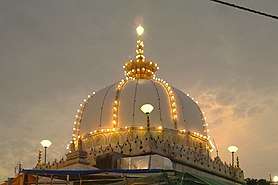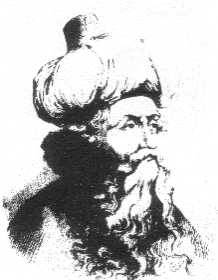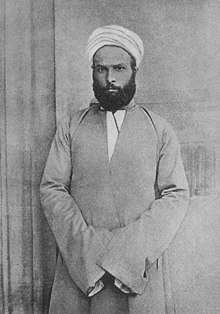''Mujaddid''
| Part of a series on Islam |
| Usul al-fiqh |
|---|
| Fiqh |
| Ahkam |
| Theological titles |
|



A mujaddid (Arabic: مجدد), is an Islamic term for one who brings "renewal" (تجديد tajdid) to the religion.[1][2] According to the popular Muslim tradition, it refers to a person who appears at the turn of every century of the Islamic calendar to revive Islam, cleansing it of extraneous elements and restoring it to its pristine purity.[3]
The concept is based not on the Quran but on a hadith (a saying of Islamic prophet Muhammad), recorded by Abu Dawood, Abu Hurairah narrated that Muhammad said:
Allah will raise for this community at the end of every hundred years the one who will renovate its religion for it.
Mujaddids tend to come from the most prominent Islamic scholars of the time, although they are sometimes pious rulers.[2]
List of claimants and potential mujaddids
While there is no formal mechanism for designating a mujaddid, there is often a popular consensus. The Shia and Ahmadiyya[5][6] have their own list of mujaddids.[2]
First Century (after the prophetic period) (August 3, 718)
- Umar ibn Abd al-Aziz (682–720)[7][8]
Second Century (August 10, 815)
Third Century (August 17, 912)
- Muhammad ibn Ya'qub al-Kulayni (864–941)[10][11]
- Abu al-Hasan al-Ash'ari (874–936)[9][12]
Fourth Century (August 24, 1009)
- Abu Bakr Al-Baqillani (950–1013)[8][13]
- Hakim al-Nishaburi (933–1012)[10]
- Ibn Hazm (994–1064)[11]
Fifth Century (September 1, 1106)
Sixth Century (September 9, 1203)
- Fakhr al-Din al-Razi (1149–1210)[18]
Seventh Century (September 5, 1300)
- Moinuddin Chishti (1165–1240)[11]
- Ibn Arabi (1165–1240)[11]
- Ibn Taymiyyah (1263–1328)[11]
Eighth Century (September 23, 1397)
- Ibn Hajar al-Asqalani (1372–1448)[19]
Ninth Century (October 1, 1494)
- Jalaludin Al-Suyuti (1445–1505)[7][20]
Tenth Century (October 19, 1591)
- Khayr al-Din al-Ramli (1585–1671)[7]
Eleventh Century (October 26, 1688)
- Ahmad Sirhindi (1564–1624)[12][21]
- Abdullah ibn Alawi al-Haddad (1634–1720)[22]
- Shah Waliullah Dehlawi (1703–1762)[23]
Twelfth Century (November 4, 1785)
- Murtaḍá al-Zabīdī (1732–1790)[20]
- Shah Abdul Aziz Delhwi (1745–1823)[24]
- Usman Dan Fodio (1754–1817)[25]
Thirteenth Century (November 14, 1882)
- Muhammad Abduh (1849–1905)[11]
- Said Nursî (1878–1960)[26]
Fourteenth Century (November 21, 1979)
- Abul A'la Maududi (1903-1979)[27]
- Ahmad Raza Khan (1856–1921)[28]
- Mirza Ghulam Ahmad (1835–1908)[29][nb 1]
Notes
References
- ↑ Faruqi, Burhan Ahmad. The Mujaddid's Conception of Tawhid. p. 7. Retrieved 31 December 2014.
- 1 2 3 Meri, Josef W. (ed.). Medieval Islamic Civilization: An Encyclopedia. Psychology Press. p. 678.
- ↑ "Mujaddid - Oxford Islamic Studies Online". www.oxfordislamicstudies.com. Retrieved 2018-09-03.
- ↑ Sunan Abu Dawood, 37:4278
- ↑ "Religion in Southeast Asia: An Encyclopedia of Faiths and Cultures". ABC-CLIO, LLC.
- ↑ Jesudas M. Athyal, Religion in Southeast Asia: An Encyclopedia of Faiths and Cultures, (ABC-CLIO, LLC 2015), p 1. ISBN 9781610692496.
- 1 2 3 "Mujaddid Ulema". Living Islam.
- 1 2 3 4 Josef W. Meri, Medieval Islamic Civilization: An Encyclopedia, (Routledge 1 Dec 2005), p 678. ISBN 0415966906.
- 1 2 3 Waines, David (2003). An Introduction to Islam. Cambridge University Press. p. 210. ISBN 0521539064.
- 1 2 3 Waliullah, Shah. Izalatul Khafa'an Khilafatul Khulafa. p. 77, part 7.
- 1 2 3 4 5 6 7 8 Nieuwenhuijze, C.A.O.van (1997). Paradise Lost: Reflections on the Struggle for Authenticity in the Middle East. p. 24. ISBN 90 04 10672 3.
- 1 2 Josef W. Meri, Medieval Islamic Civilization: An Encyclopedia, (Routledge 1 Dec 2005), p 678. ISBN 0415966906
- ↑ Ihya Ulum Ad Din, Dar Al Minhaj: Volume 1. p. 403.
- ↑ "Imam Ghazali: The Sun of the Fifth Century Hujjat al-Islam". The Pen. February 1, 2011.
- ↑ Jane I. Smith, Islam in America, p 36. ISBN 0231519990
- ↑ Dhahabi, Siyar, 4.566
- ↑ Willard Gurdon Oxtoby, Oxford University Press, 1996, p 421
- ↑ "al-Razi, Fakhr al-Din (1149-1209)". Muslim Philosophy.
- ↑ "Ibn Hajar Al-Asqalani". Hanafi.co.uk. Archived from the original on 2004-09-02.
- 1 2 Azra, Azyumardi (2004). The Origins of Islamic Reformism in Southeast Asia part of the ASAA Southeast Asia Publications Series. University of Hawaii Press. p. 18. ISBN 9780824828486.
- ↑ Glasse, Cyril (1997). The New Encyclopedia of Islam. AltaMira Press. p. 432. ISBN 90 04 10672 3.
- ↑ "A Short Biographical Sketch of Mawlana al-Haddad". Iqra Islamic Publications. Archived from the original on 2011-05-27.
- ↑ Kunju, Saifudheen (2012). "Shah Waliullah al-Dehlawi: Thoughts and Contributions": 1. Retrieved 5 April 2015.
- ↑ "Gyarwee Sharif". al-mukhtar books. Archived from the original on 2012-04-26.
- ↑ O. Hunwick, John (1995). African And Islamic Revival in Sudanic Africa: A Journal of Historical Sources. p. 6.
- ↑ Rippin, Andrew. Muslims: Their Religious Beliefs and Practices. p. 282.
- ↑ Mawdudi and the Making of Islamic Revivalism. Oxford University Press.
- ↑ Gugler, Thomas K (2015). Ridgeon, Lloyd, ed. Sufis and Salafis in the Contemporary Age. Bloomsbury. pp. 171–189. Retrieved 8 September 2018.
- ↑ Adil Hussain Khan, From Sufism to Ahmadiyya: A Muslim Minority Movement in South Asia, Indiana University Press, 6 April 2015, p. 42.
- ↑ "Ahmadis - Oxford Islamic Studies Online". www.oxfordislamicstudies.com. Retrieved 2018-09-03.
Controversial messianic movement founded by Mirza Ghulam Ahmad in Qadian, Punjab (British-controlled India), in 1889. Founder claimed to be a “nonlegislating” prophet (thus not in opposition to the mainstream belief in the finality of Muhammad 's “legislative” prophecy) with a divine mandate for the revival and renewal of Islam ... Rejected by the majority of Muslims as heretical since it believes in ongoing prophethood after the death of Muhammad.
- ↑ "The Ahmadiyyah Movement - Islamic Studies - Oxford Bibliographies - obo". Retrieved 2018-09-03.
The Ahmadiyya Movement in Islam is a modern Muslim messianic movement. It was founded in 1889 in the Indian province of Punjab by Ghulam Ahmad (b. c. 1835–d. 1908). Having been accused of rejecting the Muslim dogma asserting the finality of Muhammad’s prophethood, the movement aroused the fierce opposition of the Sunni mainstream. During the period of British rule in India, the controversy was merely a doctrinal dispute between private individuals or voluntary organizations, but after most Ahmadis moved in 1947 to the professedly Islamic state of Pakistan, the issue was transformed into a major constitutional problem. The Sunni Muslim mainstream demanded the formal exclusion of the Ahmadis from the Muslim fold. This objective was attained in 1974: against the fierce opposition of the Ahmadis, the Pakistani parliament adopted a constitutional amendment declaring them non-Muslims. In 1984, in the framework of Ziya al-Haqq’s Islamization trend in Pakistan, presidential Ordinance XX of 1984 transformed the religious observance of the Ahmadis into a criminal offense, punishable by three years of imprisonment. The ordinance subsequently became an instrument of choice for the harassment and judicial persecution of the Ahmadi community. Following its promulgation, the headquarters of the Qadiyani branch of the Ahmadi movement moved from Rabwa, Pakistan, to London. In February 2009 the movement was headed by Mirza Masrur Ahmad, the fifth successor to the founder, who assumed office in 2003.
- ↑ "Ghulam Ahmad, Mirza - Oxford Islamic Studies Online". www.oxfordislamicstudies.com. Retrieved 2018-09-08.
Founder of Ahmadi movement in Punjab, India, in 1889... The movement is labeled non-Muslim and fiercely opposed by Muslims, although the group considers itself Muslim.
Further reading
- Alvi, Sajida S. "The Mujaddid and Tajdīd Traditions in the Indian Subcontinent: An Historical Overview" ("Hindistan’da Mucaddid ve Tacdîd geleneği: Tarihî bir bakış"). Journal of Turkish Studies 18 (1994): 1–15.
- Friedmann, Yohanan. "Shaykh Ahmad Sirhindi: An Outline of His Thought and a Study of His Image in the Eyes of Posterity". Oxford India Paperbacks